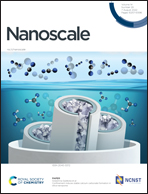Electron–phonon relaxation at the Au/WSe2 interface is significantly accelerated by a Ti adhesion layer: time-domain ab initio analysis
Abstract
Thermal transport at nanoscale metal–semiconductor interfaces via electron–phonon coupling is crucial for applications of modern microelectronic, electro-optic and thermoelectric devices. To enhance the device performance, the heat flow can be regulated by modifying the interfacial atomic interactions. We use ab initio time-dependent density functional theory combined with non-adiabatic molecular dynamics to study how the hot electron and hole relaxation rates change on incorporating a thin Ti adhesion layer at the Au/WSe2 interface. The excited charge carrier relaxation is much faster in Au/Ti/WSe2 due to the enhanced electron–phonon coupling, rationalized by the following reasons: (1) Ti atoms are lighter than Au, W and Se atoms and move faster. (2) Ti has a significant contribution to the electronic properties in the relevant energy range. (3) Ti interacts strongly with WSe2 and promotes its bond-scissoring which causes Fermi-level pinning, making WSe2 contribute to electronic properties around the Fermi level. The changes in the relaxation rates are more pronounced for excited electrons compared to holes because both relative and absolute Ti contributions to the electronic properties are larger above than below the Fermi level. The results provide guidance for improving the design of novel and robust materials by optimizing the heat dissipation at metal–semiconductor interfaces.



 Please wait while we load your content...
Please wait while we load your content...